Divers try to reach suspected AirAsia wreck site
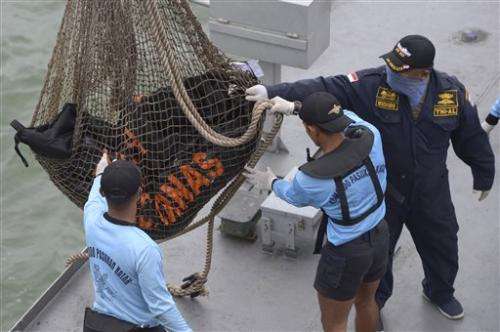
Divers were grappling with light rain and rolling waves Sunday as they tried to reach what is believed to be the fuselage of AirAsia Flight 8501, thick sediment on the sea floor leaving them with zero visibility.
So far, only 31 bodies have been recovered from last week's crash and officials believe many of the remaining 131 passengers and crew are strapped to their seats inside the plane, said Henry Bambang Soelistyo, chief of the National Search and Rescue Agency.
The two divers who successfully reached the suspected wreck site had to turn back almost immediately because of the poor conditions, he said.
The plane went down in the Java Sea on Dec. 28, halfway into a two-hour flight from Surabaya, Indonesia's second-largest city, to Singapore. Minutes before losing contact, the pilot told air traffic control that he was approaching threatening clouds, but was denied permission to climb to a higher altitude because of heavy air traffic.
What caused the disaster remains unclear, but Indonesia's Meteorology, Climatology and Geophysics Agency released a report, saying "Flight 8501 appears to have been trapped in bad weather that would have been difficult to avoid."
While the plane's black boxes—the flight data and cockpit voice recorders—have yet to be located, the discovery of the wreckage would greatly benefit the investigation.
"We are racing with time and weather in running this mission," said National Search and Rescue deputy chief Tatang Zainudin, as more than 90 divers from Indonesia and Russia waited for their chance to plunge into the relatively shallow 30-meter (98-foot) waters.
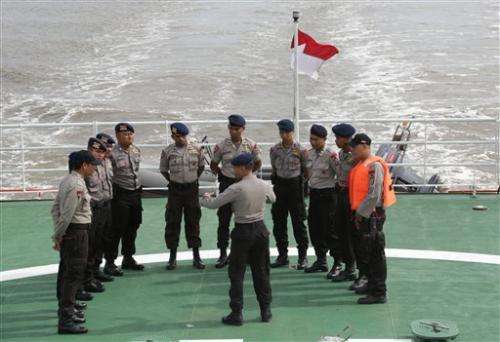
Sonar equipment identified five giant chunks on the sea bed in the search area in recent days, but no images have been captured confirming they are part of the AirAsia plane.
The biggest object, measuring 18 meters (59 feet) long and 5.4 meters (18 feet) wide, appeared to be part of the jet's body, said Soelistyo.
Early Sunday, four other chunks of debris, up to 12 meters (39 feet) long, were found, including one long, flat object. Suspected plane parts also were seen scattered on beaches during an aerial survey.
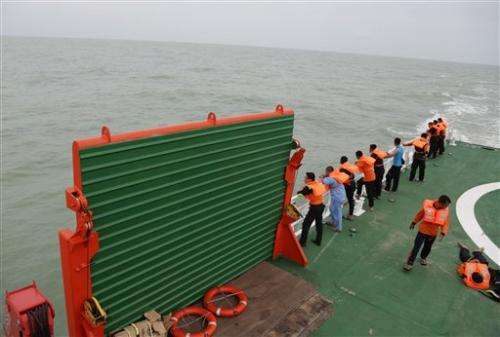
Another body was recovered from the same area, he said, bringing the total so far to 31.
Generally, aviation experts say the more passengers, luggage and parts of the aircraft that remain intact, the more likely the plane hit the water in one piece. That would signal problems like a mechanical error or a stall instead of a midair breakup due to an explosion or sudden depressurization.
-
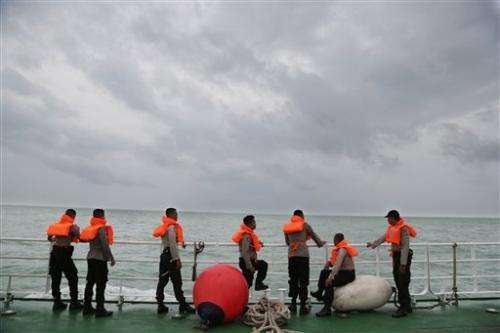
Indonesian police stand on the deck of a National Search And Rescue Agency (BASARNAS) ship during a search operation for the victims of AirAsia flight QZ 8501 on the Java Sea, Indonesia, Saturday, Jan. 3, 2015. Indonesian officials were hopeful Saturday they were honing in on the wreckage of the ill-fated jetliner after sonar equipment detected large objects on the ocean floor, one week after the plane went down in stormy weather. (AP Photo/Achmad Ibrahim) -
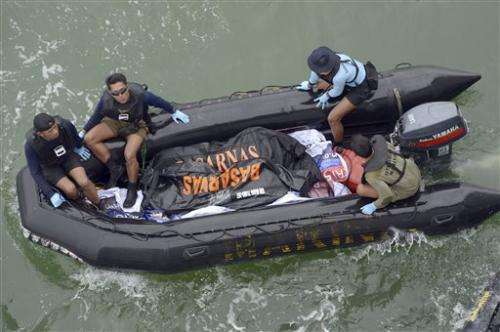
Indonesian Navy personnel carry a plastic bag containing the dead body of a passenger of AirAsia Flight 8501 at sea off the coast of Pangkalan Bun, Indonesia, Saturday, Jan. 3, 2015. Indonesian officials were hopeful Saturday they were honing in on the wreckage of the flight after sonar equipment detected two large objects on the ocean floor, a full week after the plane went down in stormy weather. (AP Photo/Adek Berry, Pool) -
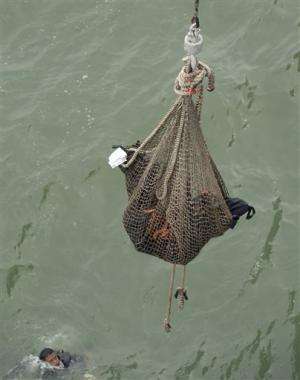
Bags containing dead bodies of the passengers of AirAsia Flight 8501 are lifted to Indonesian navy vessel KRI Banda Aceh at sea off the coast of Pangkalan Bun, Indonesia, Saturday, Jan. 3, 2015. Indonesian officials were hopeful Saturday they were honing in on the wreckage of the flight after sonar equipment detected two large objects on the ocean floor, a full week after the plane went down in stormy weather. (AP Photo/Adek Berry, Pool)
© 2015 The Associated Press. All rights reserved.

















